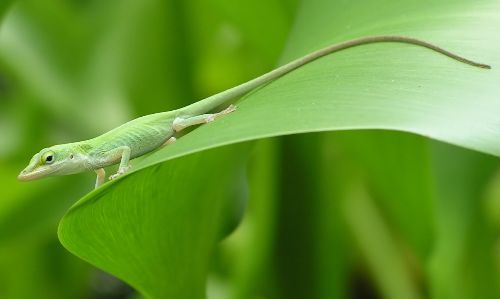by Valerie
November, 2003Green Anole
With this issue, we are introducing a new feature that will highlight the many residents in our yard and gardens. I can think of no better subject for the first one than our favorite lizard, the green anole (Anolis carolinensis). For several years after we moved into our present house, I despaired of ever seeing anoles in our yard. They seemed abundant all over Austin, but our gardens were not yet attractive enough for these delightful reptiles. Eventually, though, they did move in, and now we have so many that sightings are guaranteed throughout the warmer months. The lizard in the accompanying photograph is a youngster that took up residence in our pond this past summer. It frequently hunted among the water hyacinths and its usual bright green color blended in very well. Anoles need to remain camouflaged because they are always in danger of being attacked by birds. I've seen missing tails, bad cuts to the side, and various other scrapes and injuries that probably occurred in such encounters. The tails grow back and the cuts tend to heal if the anole survives. One reason that the anoles are so easy to watch is that they are homebodies, remaining in the same territory all season, so we know where to look for them. A large male will usually dominate a prime area, such as the compost bins or a particular garden segment. Within this area will be various females and young. When young males get too big, the resident male chases them off. Green anoles are sometimes sold as pets and are called "chameleons" because of their ability to change color. They are not closely related to true chameleons, which are Old World reptiles. The anoles' color can change rapidly enough that we've seen it occur. There are no set rules, but when the lizards are warm and active, they are usually green. When they are cooler or resting, they are often a greenish-brown. On very cold days, they can be so dark brown as to seem almost black. They also seem to change from green to brown when anxious about our presence. Squabbling males take on colors according to how they are doing in the dispute: green means they are winning and brown is for losers. Anoles have very good eyesight and frequently look right at us when we approach. During mating season, the dominant males may even extend their dewlap to show us who is boss, but much of the time they simply notice us and then go about their business, making them excellent photographic subjects. |
(Garden Dragons is an article on "larvalbug's garden" which provides more photos and information on green anoles.)
